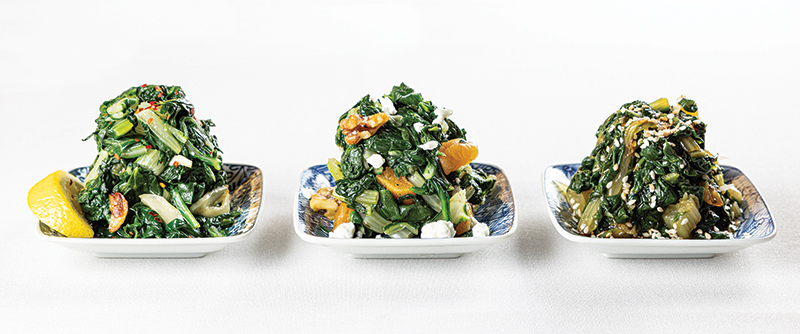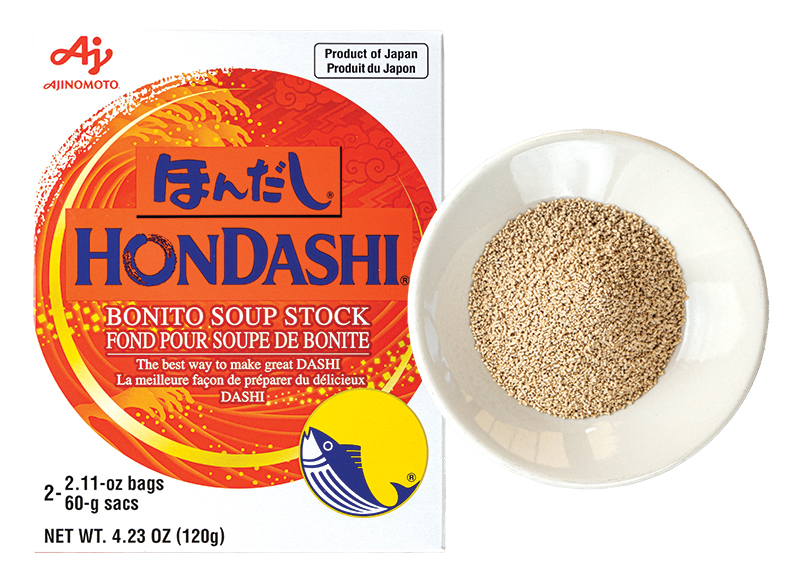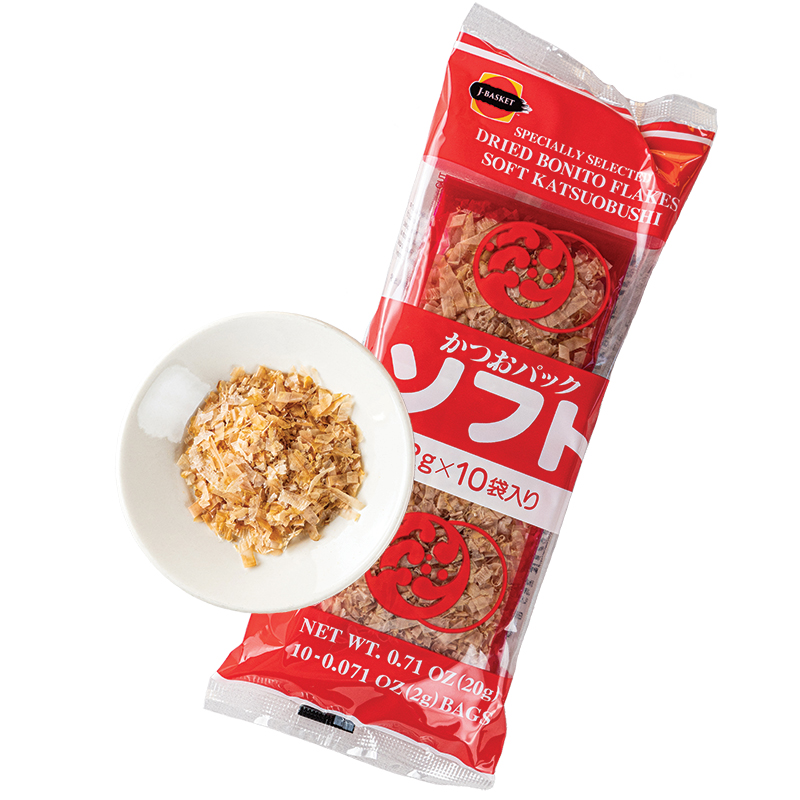
Spring is so close I can almost taste it. If you love bright, vibrant vegetal flavors and are tiring of complex, long-cooked braises and root vegetables—lovely as they are during the depths of winter—then March is a restless time of year. Impatient gardeners, anxious to get their hands in the soil, probably have a good number of seeds sprouting. But cooks who love creating with fresh, seasonal ingredients still have to work with what they can get at the grocery store.
The earliest greens of our Midwestern spring include spinach, dandelions, and cold-tolerant lettuces. In specialty grocery stores and farmers markets you may find greater variety thanks to greenhouses, poly tunnels, and other growing techniques that take more energy and time than available to the hobbyist gardener who also has a full-time job. Otherwise, you are most likely limited to Swiss chard, kale, and bagged baby spinach at your local grocery. Regardless of the greens available to you, the following technique for quick-cooking greens comes in handy—and it’s great for those who like to do weekly meal prep or have limited space in the refrigerator where bulky raw greens take up valuable real estate. The flavors are endlessly variable and can be made to accompany just about any cuisine the world over. Enjoy and remember—spring is almost here!
Swiss Chard Three Ways
The first step to cooking fresh tasting greens is buying the freshest greens possible. I usually plan for an 8-ounce bundle or bag of greens to feed two people (quite generously). If the greens are in a bundle, be sure to give them a good once-over and make certain there is no visible decay (those twist ties and rubber bands can be very damaging), and select those with intense color. Also, pick the most crisp of what is on offer—greens lose moisture the longer they are in storage. Bagged greens should be even more thoroughly examined—no visible slime or dark or milky liquids. If your choices are questionable, it might be a good day to have cabbage—in which case you can quit reading and find another recipe (click here for the chopped cabbage salad recipe featured in the January 2022 issue).
For all three of the variations, begin by washing the greens. If using chard, strip the leafy part from the stalk. Put both parts in a large bowl of water and let them soak and allow any sediment to settle to the bottom while you assemble the rest of your tools and ingredients (if using kale, discard the stalk). Next bring a roomy pot of lightly salted water to a boil. If you want to keep your greens brightly colored (like for a photograph in a magazine, or to cook later in the week), have a large bowl of ice water ready to stop the cooking (chefs call it “shocking” the vegetable). Drain the chard and cut the greens into one-inch wide strips. Cut the stalks into half-inch wide pieces, discarding any discolored bits from the end. Put the chard stems in the boiling water and cook for three to four minutes (they should still be resilient but tender). Next, add the leafy greens and cook for two minutes more (bagged greens or spinach need only about one minute of cooking, so if using those, adjust your time accordingly. Scoop everything out with a spider (or drain the greens in a colander over the sink) and immediately plunge the greens into the ice water. Stir them, separating any clumps so that they cool quickly and thoroughly. When fully shocked, drain them again, gently squeezing to remove excess moisture. This blanching step can be done when you have the available time, up to a week in advance. The remaining steps take only a few minutes and can be completed at the last moment before serving, or prepared earlier and served either warm or at room temperature.
Greens With Lemon and Olive Oil (The most basic and versatile version—really, it goes with anything.) Peel and slice 2-4 cloves of garlic. Heat a pan large enough to contain the greens, pour in a few tablespoons of extra-virgin olive oil, add the garlic, and cook briefly until the garlic begins to color around the edges. Add a small (or large, depending on your preference) pinch of crushed red pepper flakes (Aleppo pepper is delicious here) and toast briefly. Drop in all of the blanched greens and stems at once, sprinkle lightly with salt, and stir, tossing occasionally until the greens are heated through. To serve, off the heat add a squeeze of fresh lemon juice and a drizzle of evoo (good olive oil always has more flavor when it isn’t subjected to heat). For a more filling variation, top the greens with seasoned, crunchy toasted breadcrumbs or a sprinkling of grated cheese. The addition of chopped charred scallions is delicious, but begins taking the recipe away from simplicity and freshness.
Greens With Dried Fruit, Nuts and a Hint of Spice (To accompany dishes that need a hint of sweetness, especially if the meal has Middle Eastern, Indian or North African tendencies.) Roughly chop a small handful of dried apricots (or other dried fruit) and put them in a small bowl, covering them with hot water to rehydrate them slightly—I use some of the boiling water from blanching the greens. In a skillet, pour in a few tablespoons of good oil and briefly sauté either a few cloves of sliced garlic or half a thinly sliced onion, and a handful of roughly chopped walnuts (or other nut). When the garlic is golden, add the greens, toss, and then season with salt, pepper, and a scant pinch of cinnamon. Toss briefly and taste, adjusting seasoning as necessary. To serve, crumble a bit of feta or goat cheese on top—if using good feta, a splash of the cheese brine could be a nice addition. The variation mellows nicely when allowed to stand for a bit, but can be eaten straight out of the skillet.
Greens Oshitashi/Ohitashi style (Perfect for any Asian, especially Japanese-themed, meal or as a healthful and quick, standing-in-front-of-the fridge, right-out-of-the container snack.) This Japanese preparation is normally applied to spinach, but works equally well with other greens. It is normally served room temperature to cool, and in cute little individual servings (see photo). In a bowl large enough to hold the cooked greens, combine ½ teaspoon hondashi (see In the Pantry), ½ teaspoon mirin, 1 ½ teaspoon soy sauce or tamari and a few drops of sesame oil (omit for cleaner flavor). Stir the mixture until the hondashi powder is dissolved, then add the blanched chard and continue tossing until the greens are completely dressed. In an ideal world, the greens will marinate for 30 minutes to 24 hours, but I seldom find myself in an ideal world. To serve—if the greens have given off a substantial amount of liquid (chard won’t give off nearly as much as spinach), gently squeeze the greens, reserving the marinade. Place them in serving bowls, drizzle with just a little bit of the marinade, and garnish with toasted sesame seeds and possibly a sprinkling of bonito flakes (optional—see Pantry). This technique of marinating and serving at chilled or room temperature works with many vegetables, so feel free to experiment.
In the Pantry: A Savory Boost
Japan has given the world the word for the fifth taste, the savory flavor and quality of foods: umami. Rightly enough, Japanese cuisine has a great variety of culinary tools to increase this savory quality in many dishes. Here are some of the most readily available and easiest to use to enhance many of your dishes, as well. Keep an eye out for them in larger grocery stores or those specializing in Asian ingredients.
 Hondashi
Hondashi
Instant dashi powder is a fast and easy form of dashi, the fundamental umami-rich broth of Japanese cuisine. Think of it as a high-quality bouillon cube but in granulated form. It’s great when you’re in a hurry or simply don’t want to make your own dashi. It is composed of dried ground bonito, seaweed, and all the other seasonings required for dashi stock—and usually a good dose of MSG. It is intensely flavored—one teaspoon granules in a quart of water is enough. Great for enhancing dressings, or making a quick cup of hot broth when you want something savory and warm on a chilly day (garnish with a few bits of scallion and maybe a thin slice of raw ginger for added deliciousness). Hondashi is relatively inexpensive (especially considering the price of individual ingredients for a good dashi) and has a very long shelf life.
 Miso
Miso
Not just for the classic miso soup, this complex flavor bomb is made from salty fermented soybean paste. It comes in red (the most aggressive) or white (sweeter, more delicate, with generally less salt and shorter fermentation time) with lots of variation in-between. They can be used interchangeably in an emergency (or when you just don’t feel like going out to find the kind you don’t have). Try whisking into salad dressings and marinades, or adding to vegetarian dishes to increase the umami flavor.
 Bonito Flakes
Bonito Flakes
A fish in the mackerel family, bonito is used in combination with kombu (dried kelp) to make dashi (see hondashi above). Bonito are steam-processed, dried to wood-like hardness, then shaved into flakes of different sizes. The flakes are sold in cellophane packages of various sizes (single use to multiple) and are highly perishable when exposed to air and moisture. Store in an airtight container and use as soon as possible after opening. For a neat and tasty dinner party trick, try sprinkling them over a hot dish right before you serve it—it’s really cool (and slightly disturbing) the way they wave at you as if in greeting or celebration.


